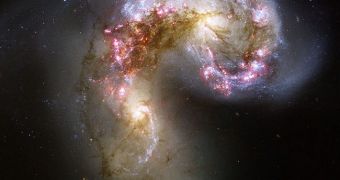Cosmic collisions and explosions taking place as far away as the other side of the galaxy could pose a significant risk to life here on Earth. This class of events has the potential to trigger the release of unfathomably-large amounts of radiations, which the magnetosphere will not be able to deflect.
Usually, our planet's magnetic shield protects us from solar radiation and cosmic rays, but it, too, has its limits. If a sudden and powerful burst of radiations were to strike in a focused blast, then the magnetosphere would be rendered useless.
If a pair of stars in a binary system collide, for example, the event would trigger the emission of huge gamma-ray bursts. If they strike the planet, these radiations are perfectly capable of depleting the entire ozone layer within a very short time frame.
Without it, ultraviolet radiation from the Sun would bathe Earth's surface, causing a sharp increase in skin cancer cases and triggering genetic mutations in any species that come in their path. It is currently uncertain whether plants would be able to endure such a phenomenon. Space reports.
In an interesting new study, experts are now beginning to search for correlations between the timing of mass extinctions that occurred on Earth and the times when massive cosmic explosions are known to have occurred in the galaxy.
“We find that a kind of gamma-ray burst – a short gamma-ray burst – is probably more significant than a longer gamma-ray burst. The duration is not as important as the amount of radiation,” a statement from Washburn University expert and study researcher Brian Thomas reads.
The astronomer says that additional details of the research will be presented tomorrow, October 9, at the annual meeting the Geological Society of America is holding in Minneapolis, Minnesota.
According to astrophysicists, short-hard gamma-ray bursts usually last for less than a second, but they tend to carry more radiations than their longer, brighter counterparts. If such blasts were to strike Earth, they would lead to the development of nitrous oxide in the atmosphere.
These chemicals are well known for attacking and destroying ozone. The chemicals would be produced in sufficient amounts to have devastating consequences. To make matters even worse, they have an extremely long lifespan in the atmosphere, and can only be removed by precipitations.
Most often, short gamma-ray busts are produced by collisions between objects much heavier than stars, such as for example black holes, neutron stars, pulsars and magnetars. Astronomers say that numerous such objects exist within our galaxy.

 14 DAY TRIAL //
14 DAY TRIAL //